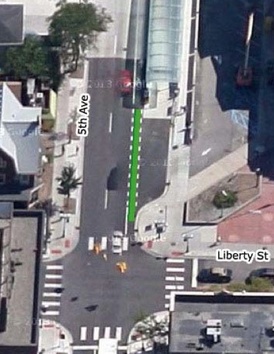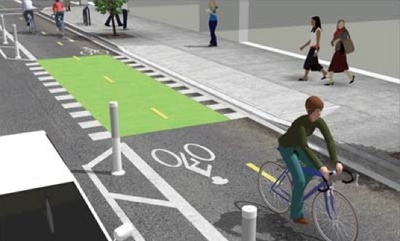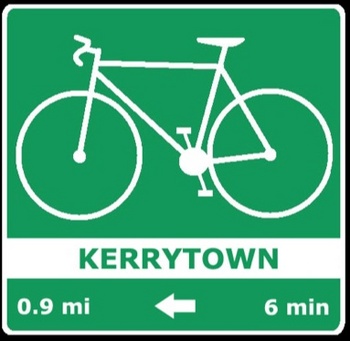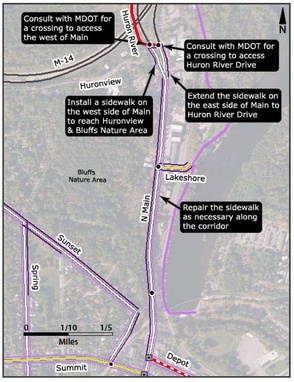Ann Arbor officials have released a draft update of the city's Non-Motorized Transportation Plan after a year and a half spent taking a fresh look at all things walking and biking.
The 62-page report is the first update to the plan since 2007 and includes new policy recommendations on everything from bike lanes to crosswalks to new sidewalk funding.
It discusses coloring some bike lanes green, launching a community bike sharing program and creating special "bike boulevards" and "cycle tracks."

Ann Arbor's non-motorized plan update shows this example of what a green-colored bike lane could look like along southbound Fifth Avenue just south of Liberty Street, where cars must cut through the bike lane to enter the ramp down into city's new underground parking garage.
City of Ann Arbor
The Planning Commission passed a resolution Tuesday night encouraging the City Council to authorize distribution of the draft to surrounding municipalities, the University of Michigan, and other stakeholders for feedback before it's officially adopted as part of the city's master plan.
"The review aspect is important as it allows for folks to see what we are suggesting and provide feedback prior to formal consideration and adoption," said Eli Cooper, the city's transportation program coordinator.
"As a planner, public input is a fundamental building block to crafting a plan that is both technically sound and also acceptable to the community."
The report recommends colored bike lanes at locations where conflicts arise between bicycles and automobiles due to configuration of bike lanes, travel lanes, and turning lanes.
Adding color to some bike lanes, the report states, can help increase visibility of the bike lane, reaffirming the cyclist's place in the road and encouraging drivers to yield.
The plan shows an example of what a green-colored bike lane could look like along southbound Fifth Avenue just south of Liberty Street where cars must cut through the bike lane to enter the ramp down into city's new underground parking garage.
"The goal of green pavement for bikes is to create a safe and unique lane that sends a clear message to all road users," the report states.
In addition to Fifth Avenue, the report recommends westbound Catherine Street from Fourth Avenue to Main Street as another potential location for a green bike lane.
One portion of the report talks about engineering special "bike boulevards," or low-traffic, low-speed roads where bicycle interests are prioritized.

The city's non-motorized plan update includes this illustration from the National Association of City Transportation Officials showing what a two-way cycle track looks like. A cycle track is a buffered bike lane that uses pavement markings or physical separators or barriers to protect the bike lane from traffic.
City of Ann Arbor
"Typically, bike boulevards are designated on streets that parallel to a major roadway not suitable for accommodating bicycling," the report states. "Bike boulevards are created by deploying a system of signs, pavement markings, low speed limits, and intersection treatments facilitating an environment that welcomes cyclists and discourages automobile through traffic."
The report notes Washington Street is a candidate for conversion to a bike boulevard to serve the east-west bicycle traffic between the western suburbs and downtown and campus areas.
"However, the Washington Street corridor is busy at select locations, including the segment in front of the Ann Arbor YMCA, between 1st St. and Chapin St., and staff will need to consider these factors in the bike boulevard planning process," the report states.
Another idea not mentioned in the previous non-motorized plan from 2007 is a community bike sharing program for Ann Arbor, something the Clean Energy Coalition has been working on.
A bike sharing program would enable residents, visitors and students to access a system of bicycles available throughout town. Under the program, users would be able to pick up a bike from one bike parking station, use it for a trip, and then drop it off at any of the system's stations.
"There are a number of issues that the CEC needs to explore through the planning process prior to initiating a local bike share program," the report states. "The placement of bike share facilities in downtown locations where space is limited will require careful planning."
Under a separate section, the report talks about the possibility of having bike stations that include showers and lockers, bike repair and rental, refreshments, bike maps, and sale of parts and accessories. It's not readily apparent the city has an immediate opportunity for a standalone bike station, the report states, but the YMCA on Washington Street and city hall on Huron Street both have locker rooms and showers and could offer a first step toward a bike station concept.
"It is recommended that the non-motorized program explore willingness of these community resources to expand access to bike support facilities," the report states, going on to mention the possibility of building a bike station in conjunction with a new Amtrak station in Ann Arbor.

The plan update recommends branding the non-motorized system by installing signs displaying direction and distance information to popular destinations throughout the city. The thinking is that would help encourage more walking and biking to places such as Kerrytown.
City of Ann Arbor
A cycle track is a buffered bike lane that uses pavement markings or physical separators or barriers to protect the bike lane from traffic. Cycle tracks can be one-way or two-way. Some cycle tracks are elevated from the road by a few inches to further separate bicycles from traffic.
A small segment of Catherine Street and Zina Pitcher Place near the U-M Medical School could provide a setting for Ann Arbor's first cycle track, the report states.
The report also recommends branding the non-motorized system by installing signs displaying direction and distance information to popular destinations throughout the city. The thinking is that would help encourage more walking and biking to places such as Kerrytown.
City officials have discussed special assessments as a funding mechanism for new sidewalks where there are gaps in the sidewalk system, but the plan update notes property owners often are opposed to that. The report indicates that's why many gaps identified in 2007 remain unaddressed.
The city's special sidewalk millage approved by voters in 2011 only covers repair and replacement of damaged sidewalks, not installation of completely new sidewalks. To address the sidewalk gaps in the city, the new report states a wide-scale funding program is needed.
The plan update maintains the 2007 recommendation to estimate the total cost of filling gaps, and it expands on that to prioritize the search for sidewalk funding programs in the near term.
A funding source also needs to be identified for installing, improving and maintaining mid-block crossings throughout the city, the report states, noting there still are nearly 100 crossings that were identified in 2007 as near-term opportunities that remain unfunded.

The non-motorized plan update includes suggestions for a stretch of North Main Street that lacks accommodations for pedestrians and bicyclists.
City of Ann Arbor
The report includes a map showing 24 locations where flashing beacons could be installed at an average cost of $12,500 — or about $300,000 for all 24 locations.
Additionally, the plan update identifies near-term opportunities for improvements on AnnArbor-Saline Road, Depot Street, Jackson Avenue, Huron Street, Dexter Avenue, North Main Street, South Main Street, Miller Avenue, Platt Road, Huron Parkway, South State Street, Washtenaw Avenue, William Street and other areas around downtown and the University of Michigan campus.
There also are long-term recommendations for the proposed Allen Creek Greenway, the Border-to-Border Trail and paths in Gallup and Fuller parks.
The report highlights the city's progress since 2007 on becoming a friendlier place for bicyclists and pedestrians, noting 35.6 miles of bike lanes have been added (up to 70.4 miles now) and 5.7 miles of shared-use arrows have been added to encourage motorists to share the road with bicyclists.
As far as pedestrian improvements, 29 major crossings have been added (up to 88 now) and seven minor crossings have been added (up to 21) since 2007, along with 3.4 miles of new sidewalks.
The report includes some documentation of the impacts of non-motorized improvements, noting 354 bicyclists were observed during a count in 2007 at the intersection of Liberty and Seventh. After bike lanes were added on Seventh, 488 bicyclists were observed during a count in 2011.
- Download the report to see the specific recommendations for new shared-use paths, bike lanes, sidewalk improvements and traffic lane reductions on the various roadways.
The 24 pedestrian crossing locations where city staff thinks flashing beacons could be installed at an average cost of $12,500 — or about $300,000 for all 24 locations.
City of Ann Arbor
Ryan J. Stanton covers government and politics for AnnArbor.com. Reach him at ryanstanton@annarbor.com or 734-623-2529. You also can follow him on Twitter or subscribe to AnnArbor.com's email newsletters.